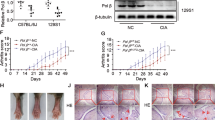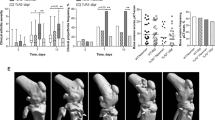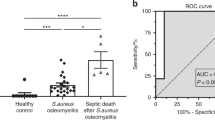Abstract
Unmethylated CpG motifs are often found in bacterial DNA, and exert immunostimulatory effects on hematopoetic cells1,2,3. Bacteria produce severe joint inflammation in septic and reactive arthritides; bacterial DNA may be involved in this process. We injected bacterial DNA originating from Escherichia coli and Staphylococcus aureus and oligonucleotides containing CpG directly into the knee joints of mice of different strains. Arthritis was seen by histopathology within 2 hours and lasted for at least 14 days. Unmethylated CpG motifs were responsible for this induction of arthritis, as oligonucleotides containing these motifs produced the arthritis. The arthritis was characterized by an influx of monocytic, Mac-1+ cells and by a lack of T lymphocytes. Depletion of monocytes resulted in abrogation of the synovial inflammation. Tumor necrosis factor (TNF)-α, a cytokine produced by cells of the monocyte/macrophage lineage, is an important mediator of this disease, as expression of mRNA for TNF-α was evident in the inflamed joints, and the CpG-mediated inflammation was abrogated in mice genetically unable to produce this cytokine. These findings demonstrate that bacterial DNA containing unmethylated CpG motifs induces arthritis, and indicate an important pathogenic role for bacterial DNA in septic arthritis.
This is a preview of subscription content, access via your institution
Access options
Subscribe to this journal
Receive 12 print issues and online access
$209.00 per year
only $17.42 per issue
Buy this article
- Purchase on Springer Link
- Instant access to full article PDF
Prices may be subject to local taxes which are calculated during checkout



Similar content being viewed by others
References
Krieg, A.M. et al. CpG motifs in bacterial DNA trigger direct B-cell activation. Nature 374, 546–549 (1995).
Klinman, D.M., Yi, A.K., Beaucage, S.L., Conover, J. & Krieg, A.M. CpG motifs present in bacterial DNA rapidly induce lymphocytes to secrete interleukin 6, interleukin 12, and interferon gamma. Proc. Natl. Acad. Sci. USA 93, 2879– 2883 (1996).
Sparwasser, T. et al. Bacterial DNA causes septic shock. Nature 386, 336–337 (1997).
Goldenberg, D.L. Septic arthritis. Lancet 351, 197– 202 (1998).
Tarkowski, A. & Wagner, H. Arthritis and sepsis caused by Staphylococcus aureus: can the tissue injury be reduced by modulating the host's immune system? Mol. Med. Today 4, 15–18 (1998).
Verdrengh, M. & Tarkowski, A. Role of neutrophils in experimental septicemia and septic arthritis induced by Staphylococcus aureus. Infect. Immun. 65, 2517–2521 (1997).
Calame, W., Douwas-idema, A.E., van den Barselaar, M.T., Furth, R.V. & Mattie, H. Influence of cytostatic agents on the pulmonany defence of mice infected with Klebsiella pneumoniae and on the efficacy of treatment with ceftriaxone. J. Infect. 29, 53–66 ( 1994).
Hultgren, O., Eugster, H.P., Sedgwick, J.D., Körner, H. & Tarkowski, A. TNF/LTα double mutant mice resist septic arthritis but display increased mortality in response to Staphylococcus aureus. J. Immunol. 161, 5937–5942 (1998).
Williams, R.O., Feldmann, M. & Maini, R.N. Anti-tumor necrosis factor ameliorates joint disease in murine collagen-induced arthritis. Proc. Natl. Acad. Sci. USA 89, 9784 –9788 ( 1992).
Parks, E. et al. Transient gene transfer of IL-12 regulates chemokine expression and disease severity in experimental arthritis. J. Immunol. 160, 4615–4619 (1998).
Mauritz, N.J. et al. Treatment with IFN-gamma triggers the onset of collagen arthritis in mice. Arthritis Rheum. 31, 1297– 1304 (1988).
Zhao, Y.X., Nilsson, I.M. & Tarkowski, A. The dual role of interferon-gamma in experimental Staphylococcus aureus septicaemia versus arthritis. Immunology 93, 80 –85 ( 1998).
Bird, A.P. CpG-rich islands and function of DNA methylation. Nature 321, 209–213 (1986).
Geselowitz, D.A. & Neckers, L.M. Analysis of oligonucleotide binding, internalization, and intracellular trafficking utilizing a novel radiolabeled crosslinker. Antisense Res. Dev. 2, 17–26 (1992).
Bennett, R.M., Gabor, G.T. & Merritt, M.M. DNA binding to human leukocytes. J. Clin. Invest. 76, 2182–2190 ( 1985).
Yi, A.K. et al. CpG motifs in bacterial DNA activate leukocytes through the pH-dependent generation of reactive oxygen species. J. Immunol. 160, 4755–4761(1998).
Baeuerle, P.A. & Henkel, T. Function and activation of NF-kappa B in the immune system. Annu. Rev. Immunol. 12, 141–179 (1994).
Wright, S.D., Ramos, R.A., Tobias, P.S., Vlevitch, R.J. & Mathison, J.C. CD 14, a receptor for complexes of Lipopolysaccharide (LPS) and LPS binding protein. Science 249, 1431–1433 (1990).
Jonsson, R., Tarkowski, A. & Klareskog, L.A. Demineralization procedure for immunohistopathological use. J. Immunol. Methods 88, 109– 114 ( 1986).
Zhao, Y.X., Ljungdahl, A., Olsson, T. & Tarkowski, A. In situ hybridization analysis of synovial and systemic cytokine messenger RNA expression in superantigen-mediated Staphylococcus aureus arthritis. Arthritis Rheum. 39, 959– 967 (1996).
Author information
Authors and Affiliations
Corresponding author
Rights and permissions
About this article
Cite this article
Deng, GM., Nilsson, IM., Verdrengh, M. et al. Intra-articularly localized bacterial DNA containing CpG motifs induces arthritis. Nat Med 5, 702–705 (1999). https://doi.org/10.1038/9554
Received:
Accepted:
Issue Date:
DOI: https://doi.org/10.1038/9554
This article is cited by
-
Staphylococcus aureus lipoproteins promote abscess formation in mice, shielding bacteria from immune killing
Communications Biology (2021)
-
Cationic nanoparticle as an inhibitor of cell-free DNA-induced inflammation
Nature Communications (2018)
-
Pathogenesis of Skin Injury of Systemic Lupus Erythematosus
Current Rheumatology Reports (2018)
-
Polymorphism and protein expression of MUTYH gene for risk of rheumatoid arthritis
BMC Musculoskeletal Disorders (2017)
-
Arthritis models: usefulness and interpretation
Seminars in Immunopathology (2017)



